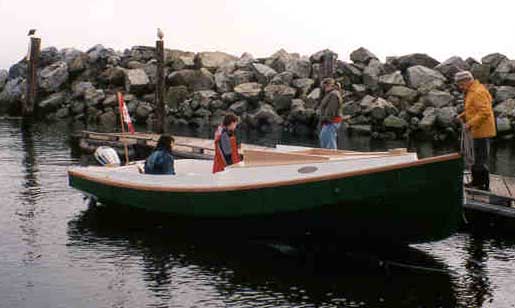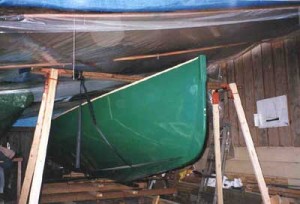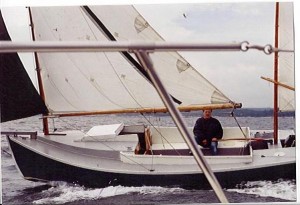Chebacco News 29 – January 2000
“Masts and sails not included”
Jamie Orr’s ‘Wayward Lass’ afloat for the first time
Jamie Orr (Victoria, BC) writes:
Big news day! Boxing Day, 1999, finally saw Wayward Lass launched, albeit as a motorboat. There’s a bit of trim to be added and/or finished yet, but I wanted to get into the water before the new year. For convenience, and to avoid having to flush the engine after, I thought we’d go in at Elk Lake, just outside Victoria. We had quite a bunch of spectators, with both my family and Maureen’s on hand for Christmas. We backed the boat down to the water’s edge, and my daughter Lindsay christened her, smacking the bow with a (plastic) bottle of Sprite, then spraying it thoroughly with the contents. After that, though, complications set in — the boat couldn’t be pushed off the trailer as the lakeshore shelves very gradually and I couldn’t back far enough in. After a quick discussion, we went to Plan B, and drove another few miles north to Sidney where the boat launch can handle much bigger boats than Chebacco. This time all went smoothly, and Wayward Lass floated off easily. The motor started on the first pull, and after a short warm up, six of us went out for the maiden voyage. She goes like a dream. The engine is a 5 h.p. Honda, and I think we must have reached hull speed at half throttle – at full throttle the stern wave just got a lot bigger, made me feel like a BC Ferry. At idle, the motor gradually turns itself to one side, but at anything higher, it stays centred and I can steer with the tiller. We confirmed that the hole for the centreboard pin is indeed at or below the waterline, and had to cut a quick plug to hold the inflow to an acceptable amount. We also found that the ocean squirts up through an empty centreboard case quite easily, at any decent speed. However, both of these were more or less expected, and didn’t spoil the fun. We didn’t go far as the crew found it pretty cold and we were by now behind schedule for the celebration lunch. The recovery was as easy as the (2nd) launch. The trailer was made locally by a welding shop, and they did a great job. I’ve only adjusted the side bunk heights very slightly, and I have make one more small adjustment to raise the roller where the keel starts to rise to the bow. Boat and trailer follow the van so well that I’ve no worries about going anywhere, now. (I’d only ever used a boat trailer once before, about 30 years ago.) She’s back under her shelter now, waiting for the finish work I mentioned, and her sailing gear. I’ll be going as hard as I can on those now, except for the good weather days when we go for a power cruise! Chebacco’s rule!
Jamie also has advice on raising the Chebacco to get the trailer under it:
‘Wayward Lass’ in webbing slings
Jamie writes:
We put the boat on its trailer last Sunday, December 19. My dad (85 years old) and I (an aging accountant) managed the job ourselves, much to my surprise, without jacks or other lifting gear. I’ll describe in case it might help someone else with the same job. The boat was supported by three crosswise 4 x 4’s, resting across two lengthwise 6 x 6’s, with the bow and stern firmed up by separate supports. We started by knocking away the bow and stern supports, then I was able to lift up the ends, while Dad repositioned two of the 4 x 4’s about 3 feet apart, either side of what we guessed was the balance point. (Which is, I think, about a foot behind the midships bulkhead.) Then, as I lifted up each end (now quite light) in turn, Dad built up a criss-cross tower under the boat until it was almost 2 feet off the ground. The wide keel was enough to keep her balanced, although we had a strap under the bow end for insurance. After all, if she tipped, I’d have lost the boat, and either my canoe (stored on one side), or my dad (crawling around on the other)! More about the strap in a second. Once we had the boat up high enough, we still couldn’t roll the trailer under her because of the supporting tower of 2 x 4’s and 4 x 4’s. So we built up a pile of blocks, bits of wood and wedges under the tail of the skeg, and supported the bow with the strap, which was hung from a gigantic saw horse sort of affair across the foredeck, about a foot and a half or two feet above it. This saw horse is a 2 x 12 plank with 2 Black and Decker metal brackets, designed to accept 2 x 4 legs, and easily adjusted for height, length, width of plank etc. Very useful brackets, but I’ve no idea what they’re called or if they’re still being sold. The strap itself was seat belt webbing, wrapped 3 times around the plank and tied with a couple of half hitches. We pried the bow up an extra inch with a lever to try to allow for the stretch of the webbing, when we tightened it for the last time. We were then supported front and back, so could take the tower out, and remove the remains of the cradle. The trailer now ran in under the keel quite nicely. Once we had it positioned, I untied one end of the strap, and let the bow down. I had to take off one wrap, the remaining two provided enough friction to control the bow on the way down. Then we lowered the tongue of the trailer until the support under the skeg could be removed. The boat was then completely on the trailer.
Comfortable sleeping arrangements
Bob Branch writes:
Bill:
Hey, Merry Christmas from Michigan! I just read the comment in vol 28 about one owner buying an airmatress and pump. THERE IS A BETTER WAY!!! And it eliminates the pump (a special peeve of mine in semiwilderness camping). The solution is the self inflating air mattres. “Camprest” is the primary manufacturer and they are available in a variety of lengths and widths from backpacking and camping goods stores. And they are indeed self inflating. The “deluxe” versions are about 2 inches thick and lest anyone think that will not do the job, I’m here to tell you it doesn’t matter if you are sleeping on rocks or limbs, you will not feel the ground. They roll up into a roll that stores very easily. When they are inflated I adjust mine by adding a puff or two of air just so when I am rolled on my side my hip bones do not bottom out to ground. They have a layer of open cell foam in them as well as the air and besides being comfortable absolutely provide total temperature isolation from what is under you. In winter camping almost no heat loss occurs into the ground! We use them on the boat as sunpads. The 25 inch wide version is wonderful if you have the room for it because when you roll over you do not roll off. Owners should check the width of their floor space. A back saving addition is an overcover that forms the “Crazy Creek Chair”. This is a cover over the pad slides into with a few straps and a few battens that allow the pad to become the most comfortable rocking chair ever created. It can be adjusted to firmness, angle, and I don’t know how to explain how many more ways but it provides you with absolutely as much back support as your reclining rocker at home. It is wonderful after a day of no back rest on a wilderness canoe trip to lean back into one of these things and rock the evening away. On my canoe trips I have to be sure to have the tent up and camp totally made before sit into mine cause often I’ll doze off before dinner even gets made. These things will absolutely allow a wonderful night’s sleep on a rock hard surface…. and ply and epoxy sleeps that hard. Ain’t we all been there, done that, bought the tee shirt?
Bob Branch
Reassurance from Phil Bolger & Friends regarding Chebacco anxieties
Dick Burnham writes:
I wrote to Phil Bolger on some of my lingering concerns about the Chebacco and he swiftly put them to bed. I just received his letter today and rush to let you know about it. You must, though, if you’re inclined to publish some of the comments below, gain Bolger’s permission before doing so [Done that – No objections from Phil.]. For me they are comforting and offer me guidance on those things that have perplexed me some. For other, I have no way of knowing.
Maybe this is old hat for you guys. On my concern about flotation in the event of a capsize: “We’re not aware that any Chebacco has capsized. It would take a combination of very rash handling and bad luck to do it. The boat is unsinkable as designed. Any added buoyancy will float her higher if flooded.” (If you recall, Bill, I was wondering about sealed compartments and/or auto innertubes half blown up fore and aft….)
On my interest in possibly providing cross-planks to span the cockpit from seat to seat thus creating a nice sleeping platform outside: “Flush panel over the foot well is reasonable but its stowage needs study.” (My thought was to have 6 planks some 3′ long and a bit over 1′ wide so that the sum would cover from cuddy hatch aft to tiller. 3 would store under an openable seat on each side where the centerboard well is located — keeping weight low and in the center when sailing.)
On sailmaking and shaping of the sails: “We hear that the Sailrite Kits for homesewn sails are very satisfactory. Urge any sailmaker to build a deep draft into the mainsail. Too-flat sails are too common and degrade performance of gaff-rigged boats especially.” (Sailrite is “sailrite.com” on the internet and when I visited them some time back their graphics indicate cut, canvas weight, and price for mains’l, mizzen and an optional jib along with fixings such as thread that will be needed.)
He ends with a short note indicating that consultation on plans purchased from others (mine come from HH Payson) is “very limited.” I appreciate that as the price was most affordable. Yet it was a very nice consultation, indeed. [In his letter to me, Phil adds “Policy on consultation is to do the best we can to keep correspondence from biting too deeply into design time; that is the answers may be a bit abrupt at times.”]
Oh, found and instantly bought an 8′ long Papua New Guinean paddle. Wonderfully carved blade, and the whole length of the paddle from one piece of wood. The length will suffer a slice through it on a lengthy diagonal when we pack up to go home, but I’m thinking it will make a nice poling paddle when rejoined with epoxy, and with a boat or gaff hook on the upper end it might be a pretty useful memento.
Best, Dick Burnham
‘Itchy and Scratchy’ goes from strength to strength
‘Itchy and Scratchy’ flying along on a close reach
Fraser Howell, of Nova Scotia, continues to enjoy sailing his strip-built Chebacco and has had considerable success with a large jib attched to a longish bowsprit. He tells me that he’s currently making a replacement hollow mainmast, using the ‘birdsmouth’ type of construction that was written up in WoodenBoat magazine #149, 1999.
Old-style Chebacco Boats
Craig O’Donnell draws our attention to a picture of historical Chebacco boats at http://www.photolib.noaa.gov/lb_images/historic/nmfs/figb0080.htm
Craig’s own pages are, incidentally a fantastic resource for all things boaty – http://www.friend.ly.net/~dadadata
And finally
Bill Samson can be contacted on : bill.samson@tesco.net
Chebacco News is at http://members.xoom.com/billsamson
Snail mail to Bill Samson, 88 Grove Road, Broughty Ferry, Dundee DD5 1LB, Scotland.



